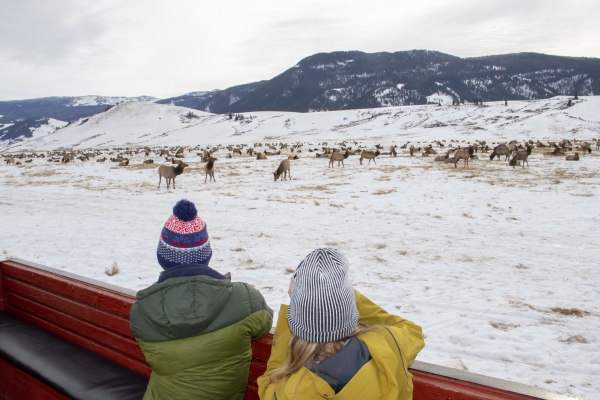
National wildlife refuges are some of the best places to enjoy both residential and migratory wildlife! Here are just a few highlights of the seasons of wildlife:
Spring
April and May are some of the best times to experience the songbird migration, particularly before the leaves are fully flushed out on the trees. Stopping at a boat landing, or along a forest trail, and taking time to scan the treetops can reward visitors with many species of warblers! Following the Great River Road on both sides of the river, you will discover many walking trails or decks with spotting scopes to help you view wildlife, but it's best to bring your own binoculars.
Summer
In the floodplain forest, great blue herons, great egrets, and double-crested cormorants nest in rookeries. Look for groups of American white pelicans feeding in formation or soaring over the refuge. Turtles bask on logs in the shallow backwaters and eleven species of frogs sing, chirp, and croak from April to August. Listen for them in the evenings along the marsh. Summer beauty shines with each month bringing new flower blossoms in the sand prairie; peak bloom time is usually in late July.
Fall
The fall water bird migration is a spectacle unlike many others! Fall colors are the backdrop for thousands of migrating birds; over 40% of the continent's waterfowl travel along the Mississippi River as they move south to warmer areas. Usually in September, dabbling ducks like wood ducks, green-winged teal, mallards, northern pintail, American gadwall and northern shovelers begin to build in numbers on the river backwaters. Typically in late September/early October, diving ducks follow, gradually forming large groups called "rafts" in open waters. Canvasback ducks, ringed-necked ducks, goldeneyes, and buffleheads are a few of these notable visitors. American white pelicans and double-crested cormorants, wading birds and shorebirds mix in shallower waters. Bald eagles ride air currents above the bluffs beside the river and perch in trees and on logs, scanning the water for an easy meal.
As the rivers and ponds in the northern United States and Canada begin to freeze over, tundra swans will arrive from the arctic sometime in mid-November, dotting the river in a sea of white birds. At peak numbers, anywhere from 10,000 - 45,000 tundra swans can be present on the river. These hungry birds will usually rest and feed until the Mississippi River also freezes over before moving on to the Chesapeake Bay area near Virginia and Maryland. The tundra swans' boisterous calls are a fall celebration.
The best places to view tundra swans are usually:
Weaver Bottoms near Weaver, Minnesota
Parking is available on a service road on the west side of Highway 61 at 116th Avenue (mile marker 45), about 1.75 miles southeast of the Highway 61/Highway 74 junction.
Shady Maple Overlook near Stoddard, Wisconsin
The Shady Maple Overlook is located off of Highway 35, about one mile south of Goose Island County Park and about three miles south of La Crosse, Wisconsin. There are several parking spots at this paved "pull off" style overlook along with interpretive signs and a spotting scope to help viewers enjoy the migration. There are no restroom facilities at this location.
Brownsville Overlook near Brownsville, Minnesota
The Brownsville Overlook is located off of Highway 26, about three miles south of Brownsville, Minnesota. This paved parking lot provides multiple parking spots and hosts a portable accessible restroom from mid-October to mid-November. Mounted spotting scopes are available for visitors to enjoy. This is a very popular spot and is less crowded during weekdays. If the parking lot is full, please do not park along the highway - try visiting the Highway 26 Overlook about a mile south of the Brownsville Overlook, or take a walk along the dike at the Reno Bottoms Canoe Trail Access about 3.5 miles south of the Brownsville Overlook, then return to see if there's space at the overlook.
Winter
Tracks in the mud and snow remind us that winter is alive with activity! Otter slides across the snow or river banks, deer tracks across the ice, and the handprint-like tracks of raccoon and opossum are often spotted on winter walks through the woods. In the prairie, see if you can spot the differences between mice, voles, and shrew prints in freshly fallen snow!
Residential birds like downy woodpeckers, white-breasted nuthatches, and northern cardinals add color and sound to an otherwise drab-colored landscape! Take a moment to still your movement and watch for winter birds flitting about on the bark and branches of trees. Raptors like red-tailed hawks and American kestrel can be seen perched above open areas during the day. Later, when the ice begins to melt on the river in mid-March, hundreds of wintering bald eagles gather around patches of open water to snatch fish in their talons, then retreat to the treetops to eat their prey.
